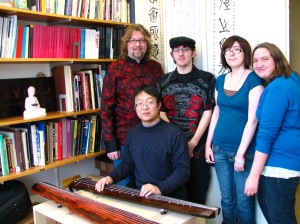To introduce who we are and what we are doing, we will post seven entries to address some fundamental issues about Guqin and this blog. Here is an index:
七月访梅庵琴社
图文/ 晴霜 配乐/于水山《忆故人》
七月中,虽是盛夏,南通因临海临江,早晚的风轻快宜人。南通是梅庵琴派古琴的发源地,在于老师的旧文里,像家一样被惦记。满怀崇敬和亲切,我随于老师在此拜访了南通梅庵琴社。
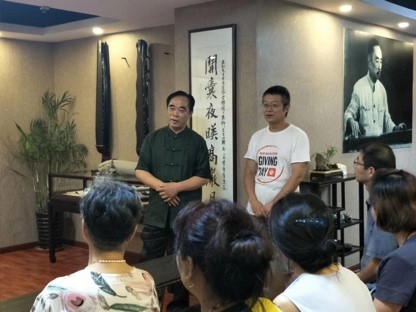
弹奏结束之后,琴友们三五成群交流起来。朱晓玫老师和于老师切磋着他们各自在《流水》中弹奏水声那一段所使用的指法,周围很快聚拢了一帮听众。我站在三步之外被那一圈热烈的讨论深深吸引,无奈当时正请袁老师帮我调试琴弦,只得艳羡地时不时观望一番。不过这反而使得我对这一番琴艺交流念念不忘,至今回忆起来仍然觉得妙趣横生、心怀向往。
此次拜访,于老师应琴社之邀,做了题为《从指法母题的变化规律看梅庵派古琴的风格特点》的讲座。老师解释了古琴指法中的“pattern”“骨骼”,并类比西方古典音乐中的动机。老师认为提出这一概念的意义之一,就是由指法母题看不同琴派围绕这同一骨骼的血肉细节的差异,将古琴文化中琴派风格的抽象描述具象到指法。在提问环节,于老师还和大家分享了他个人的对于古琴音乐创新的态度:全面了解古人对古琴艺术的成就,在当下即是创新。因为研究一个问题时,免不了要探究古人对此的看法和所做的工作;如果从研究古人的工作着手,自然会有不同于古人的新思路浮现。于老师当天的演讲和分享让琴友们非常受教,事后有琴友还专门写了文章分享其所闻所得。
南通一行,最意外的就是见到了徐立孙老先生的云钟琴。琴身漆色黯淡,断纹蜿蜒,传递着岁月静谧之美。琴背面刻着隶书云钟二字,以及王燕卿老先生的题字“开囊夜映高岩月,拂案秋涵大壑风”;字体古朴典雅,诗句气势宏伟。徐老师回忆他曾在浙江省博物馆见到一张背面刻有“名钟”的古琴,外形与“云钟”一致,推测它们本是一对。两张琴都经历了千年岁月的洗礼,一张高悬于展览柜静待访者,一张仍在琴人的手指下流淌着音乐,焕发着生命的光彩。

此行虽然短暂,却是难忘。领教了老师们的演奏,见识了云钟的风采,聆听了他们和古琴、梅庵琴派的故事。告别时刻,琴友们的谦谦风度、对古琴的热爱、交流的乐趣,都保存在记忆里。我不禁也想起了波士顿琴社的朋友们,尤其几位已经或即将奔赴前程的。南通也好,波士顿也罢,无论身在何处,每日习琴,我们都在琴声里交谈和重逢。
二〇一八年北美梅庵琴社春季雅集
天朗氣清,春好之處,北美梅庵琴社戊戌春季雅集如約而至。
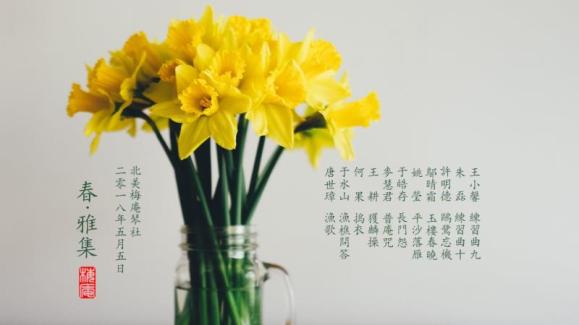
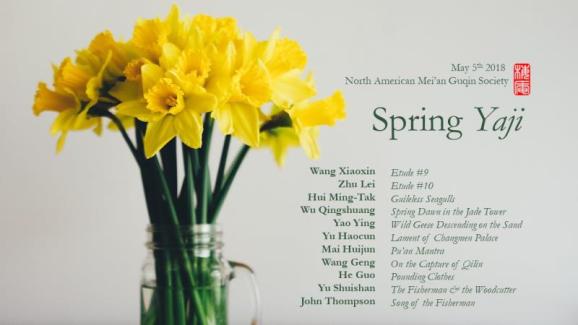
(海報製作:麥慧君)
小荷初生,琴壇翹楚。七弦安處,便是吾響。
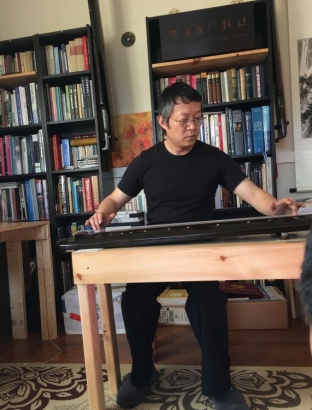
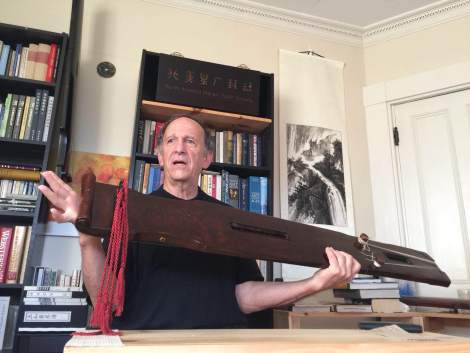

Q2-What is Meian in your title, aka. who are You?
Q1- What is Guqin?
Someone comments that the Guqin music here is “guitar-like.” There is some truth in that, but only a small grain.
开场白——代序 (柳一)
小子柳一,去年初秋开始有幸随于水山师学琴。八个月来,一直如身在大观园,满耳满目都是精彩。于师经常和我谈音律丶弦法,也讲各种琴史琴人的好玩故事。小子不才,记住的大多是后者。近一段时间由我管理琴社博客,本想待于师写一篇序言开宗明义,众人方敢下笔。无奈他诸务缠身,暂无闲暇。于是我决定先写起来,待他发现我光讲故事丶胡言乱语,不忍卒读,说不定就会来写序了。
崔莺莺月下听琴丶流放须磨的源氏在惊涛骇浪之后听明石演奏丶狭衣隔墙“观”二公主弹琴丶绿竹巷中任盈盈以《普庵咒》为令狐冲疗伤……以前读这些故事,总是被其中无言却胜千言的“琴”所打动。近来细细考量,却发觉其中大有周章:听琴者究竟是如何被打动,如何由琴及人,而及弹奏者之心的?弹奏者又是如何传情——或者如装扮成“婆婆”的任盈盈那样,“掩藏”感情的?
在中国古典文学中,对“乐”的书写大概与书写本身同样古老:乐与诗都被视作先人由内而外的丶自然且不可抑制的表达。身体之舞丶口中之音甚至先于语言存在。然而音乐无言,我只能顺着有形之言——文字上溯,希望从前人对音乐的书写中找到线索。
由唐诗开始,挑选细读写琴与其他乐器的诗,归入“琴诗”;赋丶记丶论等写到琴和音乐的韵文散文,归入“琴文”;题跋丶笔记丶轶事及今人所写的传记等,归入“琴话”。无心完备,不求系统,无非是学琴路上随读随写,过千山而偶得小石。日积月累,中间或有零玑碎锦,串起来亦可成章。
是为代序。
Members of NAMGS 北美梅庵琴社成員
North America Mei’an Guqin Society (NAMGS) was founded by Shuishan Yu in Oakland University in 2010. Here are some of our earliest members:
(Left: Kevin Naeve,Damian Holter,Lisa Schneider,Katherine Lennon. Front: Shuishan Yu)
In 2010, Oakland University officially approved a new course on Guqin (Course Numbers from beginner to higher levels: MUA126, MUA226, MUA326, MUA426, MUA526 ), which was proposed by Professors Yu and Mark Stone. This photo features the cohort of students that took the class in its first round from January to April of 2011. Other members of the Society include students who have regular private classes with Yu as well as a wide range of people who are interested in Guqin and Chinese culture.
Yu has moved to Boston in 2013 and now we are developing a new base in this beautiful city that has only Winter and Summer.
2010年,奥克兰大学正式通过了于水山和马克·斯通 (Mark Stone) 提交的古琴课开课申请(课程编号从低到高依次是:MUA126, MUA226, MUA326, MUA426, MUA526),并在2011年的冬季学期(一月至四月)成功招收了第一班学生(照片上从左到右依次是:Kevin Naeve,Damian Holter,Lisa Schneider,Katherine Lennon)。其中的Kevin Naeve 是音乐系指挥专业的硕士研究生。除了这四位正式学校注册的学生,还有几位私人学生,到家里上课的。北美梅庵琴社的成员除古琴学生外,还有大学和社区里对古琴和中国文化感兴趣的各界人士。
于水山:梅庵,南通与大洋彼岸
记得一年前去日本,在姬路城天守阁的最高层,看到了一首桃山时期武人赖山陽写的汉诗。其中有一句是,“兖州曾起阿瞒业,淮镇堪兴匡胤家。”不禁感叹日本人受 中国文化影响之深,对中国的历史掌故了如指掌。又感叹中国文化在古代东亚的崇高地位,邻国的贵族及文士都以能读汉文,写汉诗为荣。
现在看来,最应感叹的是一个地名与一段盛事的联系。兖州因曹操的崛起而名重一时,淮镇则作为宋室的龙兴之地为世人仰望,何其幸也!刚刚从南通参加梅庵琴社迁 入园博园典礼和纪念徐立孙先生逝世四十周年古琴雅集,不禁联想南通与梅庵派古琴的联系又何尝不如是。自从近一个世纪前,徐立孙和邵大苏二先生在南通创建梅 庵琴社,这种联系便形成了。
我和南通有缘,和梅庵琴社诸前辈,琴友只能用“宿世良朋”四个字来形容。这不单是因为我的老师吴自英先生是徐立孙先生的弟子,更因为从一开始我和南通的梅庵 琴社就有一种一见如故的感觉。最初和梅庵琴社取得联系则更是因缘巧合。五年前,我在上海参加世界亚洲学者大会,闲暇时造访了上海音乐学院附近的一家琴馆, 结识了年轻的琴友李俊捷先生。当时并不知道他的姓名,只以上海小友相称。李先生儒雅脱俗,弹琴喝茶,一时聊得很投缘,直到深夜。约定来日再会,不料次日因 会议的拖延直到半夜才赶到琴馆,客人都已清场。无奈之下,只以一部从美国带来的《地藏菩萨本愿经》和一张名片遗馆主,托他送给这位上海小友。没想到这竟是 与梅庵琴社结缘的开始,和严晓星先生的相识便是因李先生的介绍。严先生的才华和学识都令人钦佩。经他的联络,我于去年六月来南通梅庵琴社拜访和雅集,并有 幸拜会了年已八十的徐霖老先生。
从 最初的通过电子邮件和电话交流,到去今两年接连来南通,梅庵琴社诸前辈,同仁和琴友都给我留下了极深刻的印象。我感受到了他们对古琴的热爱,对传承和发扬 梅庵艺术深挚的责任感,感到了力量。我觉得在他们身上无私与奉献不再只是一句口号。他们大多有各自的工作且公务繁忙,然而一旦琴社有活动他们便会尽一切努 力,以不同的方式作出贡献。有这样一群人的参与,古琴何其幸也!南通的梅庵琴社也是我所见到的最为全面的琴社。他们当中,有琴派创始人的后代为导师和精神 领袖,有一批琴艺出色的年轻人为授业的骨干,有精思明辨的古琴学者做理论和历史的研究,有能弹琴的斫琴者,又有为琴社的组织与活动而辛勤奔忙的琴人。有这 样一群人的参与,梅庵琴社何其幸也!
也许正是受了他们的热情和人格的感召,我才有勇气接受组建北美梅庵琴社的委托。我在古琴界和梅庵琴人里只能算是个晚辈后学,虽然自儿时便对古琴心仪神往,但 限于条件,那时只能用一台最原始的录音机从电台里录古琴曲反复聆听。再有就是把父亲的一把坠琴改为类似三弦的弹拨乐器,横在膝上弹《梅花三弄》。直到十年 前来美国留学,我才有幸在西雅图遇到了吴自英先生,正式开始学琴。我深知自己的能力和资历都很有限,但作为一名海外的梅庵古琴的传人,我感到自己有责任为 梅庵艺术,尤其是她在大洋彼岸的传播做一点事情,才不负南通梅庵琴社的前辈和琴友们对我的信任和期望。大洋彼岸的北美对中国传统文化的了解远不如一衣带水 的东瀛,古琴的传播,尤其是在非华人圈子里的接纳与理解也要困难得多。我曾戏言,假如成立一个“日本梅庵琴社,”一定会比北美梅庵琴社搞得好。但挑战也往 往意味着机遇。在“阿瞒”与“匡胤”之前,有哪个日本武士会特别青睐“兖州”和“淮镇”呢?毕竟是梅庵琴社成就了南通与古琴的因缘,但愿大洋彼岸的奥克兰 大学也能有如此的好运。
记得去年到南通,徐霖老先生还意兴盎然地听我弹琴。虽然言语不甚清晰,但他的指点仍精恰而中肯。他的热情与对后学的殷殷提点,每每思之便倍感温暖。徐老先生今已作古,这篇文字,也算是对他的纪念吧。
2009年6月3日
(2009年6月26日《江海晚报·夜明珠》)

